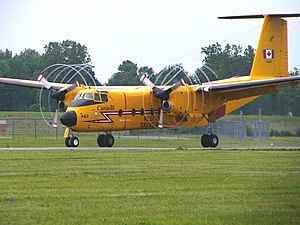CC-115 Buffalo
| DHC-5 Buffalo | |
|---|---|
 |
|
| A CC-115 Buffalo of 442 Transport & Rescue Squadron at Rockcliffe Airport in Ottawa, 2004 | |
| Role | Utility aircraft |
| Manufacturer | de Havilland Canada |
| First flight | 9 April 1964 |
| Introduction | 1965 |
| Produced | 1965–1972, 1974–1986 |
| Number built | 122 |
| Developed from | De Havilland Canada DHC-4 Caribou |
The de Havilland Canada DHC-5 Buffalo is a short takeoff and landing (STOL) utility transport, a turboprop aircraft developed from the earlier piston-powered DHC-4 Caribou. The aircraft has extraordinary STOL performance and is able to take off in distances much shorter than even most light aircraft can manage.
The Buffalo arose from a 1962 United States Army requirement for a STOL transport capable of carrying the same payload as the CH-47A Chinook helicopter.De Havilland Canada based its design to meet the requirement on an enlarged version of its DHC-4 Caribou, already in large-scale service with the United States Army, to be powered by General Electric T64 turboprops rather than the Pratt & Whitney R-2000 piston engines of the Caribou. (It had already flown a T-64 powered Caribou on 22 September 1961).
De Havilland's design, the DHC-5 Buffalo, was chosen as the winner of the United States Army competition in early 1963, with four DHC-5s, designated YAC-2 (later CV-7A and subsequently C-8A) ordered. The first of these aircraft made its maiden flight on 9 April 1964. All four aircraft were delivered in 1965, the Buffalo carrying nearly twice the payload as the Caribou while having better STOL performance. The prototype CV-7A was exhibited by the manufacturer at the 1965 Paris Air Show wearing US Army markings. No further US orders followed, however, as at the start of 1967 (See the Johnson-McConnell agreement of 1966), inter-service politics lead to large fixed-wing transports being transferred to the United States Air Force, who considered themselves adequately equipped with the Fairchild Aircraft C-123 Provider.
...
Wikipedia
